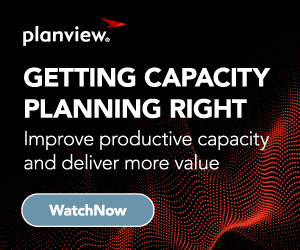
Today, organizations are constantly asked to “do more with less.”
But most organizations lack basic resourcing capacity, and plans are often approved before resource capacity is evaluated, resulting in missed objectives and employee burnout due to overutilization. Organizations require an effective capacity planning strategy.
In this blog, we highlight some best practices from our recent webinar, Getting Capacity Planning Right, with Planview’s David Blumhorst and AJ Shavell, as they demonstrate real-world examples from working with customers who are getting capacity planning right.
Understanding Resource Management
Capacity planning can take on different forms depending on whether it happens internally or externally. The object of internal resource management (PPM) is to improve the business inside the company, which often involves working with constraints, prioritizing ideas and tasks, and evaluating how many you can take on.
External resource management (PSA) involves working for external customers for a fee and balancing supply and demand as you work through opportunity intake, similar to the sales funnel. Understanding internal versus external capacity management sets the tone for the overall strategy.
Resource management is foundational to organizational success. It’s challenging to build an organization that sees long-term success without the right pieces in place.
When capacity planning, follow the 80/20 rule: solve for 80% of the capacity plan, not the 20% that isn’t yet known.
The Common Challenges of Capacity Planning
Capacity planning is crucial, but it’s not without its challenges. Traditional models follow a typical project management model with capacity dependent on the hours. In these models, planning is done by months or quarters, not daily. On the other hand, agile is more continuous, with restraints based on the team, not the role.
Internal and external capacity planning often faces challenges around resource bottlenecks. Organizations with shared or competing resources have an additional strain on capacity planning. Internal teams also must find the right level of work to drive value without burning out employees, and external teams have to balance revenue and customer satisfaction.
An agile approach to capacity planning that utilizes balanced, fixed teams can overcome many of these challenges. Working efficiently by prioritizing and picking up backlog within each team allows projects to continue without a full team restructuring for each project.
Best Practices of Capacity Planning
The key principle of capacity planning is that it is a top-down process, not bottom-up. Because projects and capacity can change so quickly, a bottom-up process makes it difficult to make adjustments. Using a top-down process allows for easier adjustments.
Capacity planning is a mid-term problem, meaning teams often look three to six months out. Teams can’t solve every detail because they don’t know the details — and they don’t need to. When capacity planning, follow the 80/20 rule: solve for 80% of the capacity plan, not the 20% that isn’t yet known.
Capacity planning requires continual adjustments. While many companies hold annual planning meetings to look at the entire year at once, business today moves too fast to be that slow. Instead, the most successful companies look at their internal capacity plan at least monthly and adjust for current work and demand. Some teams, such as capacity planning for services, need to review and adjust weekly and keep an eye on the pipeline.
Best practice for capacity planning is to follow a four-step process:
- Understand your overall demand, including looking at the intake and sales pipelines.
- Analyze your current capacity, keeping an eye on current projects and demand.
- Consider your options with scenario planning.
- Continually adapt and evolve.
Ultimately, capacity planning is an ongoing process that requires continual adjustments. To succeed, teams have to regularly dedicate time to reviewing and adjusting the capacity plan.
Next Steps
Getting capacity planning right allows organizations to maximize their resources and expand their revenue. An effective capacity planning strategy helps teams — both internal and external — do more with less and thrive.
Capacity planning is a continual process. When done well, it allows teams to adjust to changes in projects and demand so they can maximize revenue and best serve employees and clients.
Watch the on-demand webinar to learn more about the benefits of capacity planning and how the right model helps facilitate a better decision-making process to hire resources or defer/approve projects.




